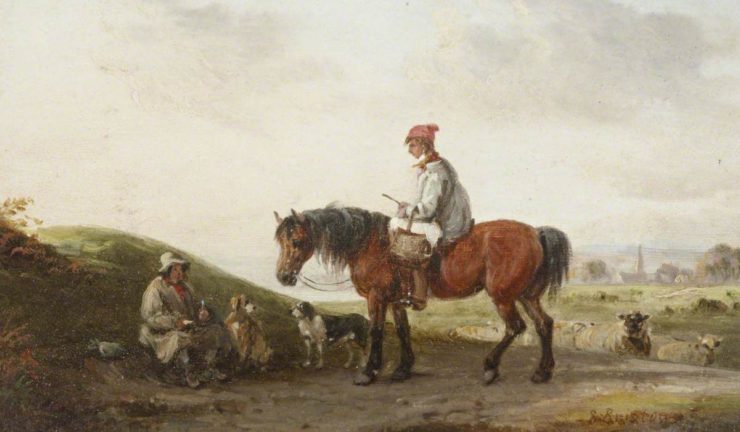A few years ago I happened across a lovely article in the New York Times. For those who don’t want to venture the paywall, the article is by Susanna Forrest, it’s titled “Two Horses, One Language,” and it explores various aspects of communication between horse and human. It’s delightful. It tells stories of the author’s own experience, with pictures of the horses. It even has a baroque horse front and center, a Lusitano of stellar pedigree and achievements.
And it has a great big gaping hole in the middle.
Here are a couple of pointers to the hole:
If I look down, I see my wobbling hands holding the reins as lightly as I can, so that the information I transmit down them to the metal bit in his sensitive mouth is a respectful but firm request and not an abrupt bark or a feeble “might I trouble you to halt?”…
Our shared language is not really a language per se, but a set of cues—a touch of the left or right heel, a shift of weight on the knee, a squeeze of hand on rein. It’s similar to but different from the cues I learned in thousands of hours of horse riding lessons as a child (squeeze, kick, pull). It’s not Sasa’s mother tongue either—he’s had to learn it from humans through classical conditioning: respond correctly and the pressure is lifted or a reward given. And yet he sometimes anticipates commands.
Sometimes she really gets it:
This is the central mystery of riding a horse: this third-language subterfuge we clever apes have to employ to communicate with a fellow mammal who is capable of reading us at a deeper and simpler level than we can read ourselves.
And then she veers off again:
This time I knew I wanted to be a better, subtler rider—the type who speaks that third language like a poet rather than a waffler, who has the proverbial “good hands.” I wanted to make succinct, eloquent gestures that were well received by my conversational partner.
This is what I call “monkey thinking.” Focusing on what we have that the horse doesn’t. Namely, hands. Thinking that hands (and to a lesser extent legs) are what we’re using to communicate. There’s a glimmer when she mentions knees, but like many other well-meaning but ultimately monkey-brained riders, she’s totally missing the part that’s doing the actual communicating.
The part that’s in closest contact with the horse. The part she’s sitting on. What the Secret Masters call the seat. (But is in fact the whole body from the shoulders to the knees.)
This view with the whole middle blanked out is strikingly common in the US. “Leg means go. Hand means stop.” In Europe it’s pretty strong, but there are places where the Real Secret is taught, such as the Spanish Riding School of Vienna.
It’s not really a secret. It’s mostly a lot more work for the rider and a lot more finesse, and takes a lot longer to learn than jump on, kick to go, pull to stop. It makes the rider pay close attention to her own body and the horse’s body, and to the intersection between the two.
And that’s where the real communication is.
Buy the Book


Over the Woodward Wall
In the way the world has of making the point with extra emphasis, the day after I first saw this article, my Evil Gelding’s new victim, er, rider was struggling a bit at the start of ride number three. She’d mounted but he wouldn’t go forward. She gave up, got off, and did work in hand instead, mostly involving getting him to do things along with her, follow and turn and speed up and slow down. Which showed her good instincts for that horse in particular.
Now Evil Gelding (who is half Lipizzan and half Arabian, which seriously doubles down on the smarts and the sensitivity) has been trained by Secret Masters, and he’s never really been ridden by Clever Monkeys. He has no “mouth” in the sense that if you pull he stops, because he’s never been communicated with in that way. When New Rider first tried him out, he kept cantering instead of trotting, because her would-be soft instructions with the legs were very loud and strong for him. Made me laugh because I had the same exact experience with his mother the first time I rode her. These horses are a whole new level of sensitive, if you’re used to the usual style of push-pull conditioning.
I quite approved her riding overall, because for all the confusions and the miscommunications, he was soft and happy throughout, and his reactions weren’t angry or frustrated. Just, hey, is this what you’re asking? Is that? Or that?
He was waiting for something. I finally, in the third ride, mentioned that if she relaxed her body while keeping it quietly upright, and lifted her pelvic floor so that his back would have room to round and come up and bring the movement through from the back to the front, he might move forward more willingly.
Bingo! New Rider is a yoga instructor, so understands both quiet uprightness and finer manipulations of the body’s core as well as the seat and pelvis. Horse picked himself up, neck stretched and got long, stride got long and loose, and he was moving on out where he’d been throwing his head up and stopping.
No hands except as a connection to his mouth. No legs at that particular point, though they would come in in various ways to finesse the seat as she went on. All she needed was to lift her core and let him move forward. She could turn by turning her body slightly. Stop pretty much by thinking it (which subliminally stopped her lower body following the movement of his hindlegs). Go forward on an exhale (which opened up the pelvis and very subtly “scooped” the horse forward from behind).
Magic.
So what was really happening?
A lot of things, but here are two important ones:
Clever Monkey walks upright and manipulates the world with her hands. She sometimes uses her legs to do things like kick the lawnmower into gear and run away from the lion in the grass.
Horse on the other hand is built on a rectangle. The engine is in the rear. The front end is designed to reach down and graze, or reach up and browse, but when it’s time to run away from the lion, the back end is where the motion starts. Tuck the rear, thrust off, runlikehell.
When we put a monkey in the middle of this structure, monkey wants to control the part she can see, which is the head and neck. Horse on the other hand is still a rear-wheel-drive vehicle. Pulling on his face doesn’t make a lot of sense except insofar as it interferes with his ability to run away from that lion. Which is why pulling too hard often results in his rearing up and falling over backwards. His back end is where he’s focused.
Realizing that it’s not the legs or the hands that control the horse, but the rider’s weight and, when the horse is not deadened to it by a long history of riders without awareness, the structure of the rider’s pelvis (what we call the seatbones), is the point at which monkey starts to become an actual rider. That’s when she starts communicating with the horse not through cues (artificial signals) but through aids (signals that when properly applied encourage the horse to move in the direction desired). A cue would be lift of one rein equals canter. An aid uses the rider’s weight, legs, and hands to position the horse’s legs and body in such a way that he has to canter; there’s no other answer to that question.
A trainer would actually have to train the horse with aids, and then connect the cue to those aids. Then the untrained rider just lifts the rein and mostly gets the response, as long as the rider isn’t interfering too strongly with the horse’s ability to do it. What you get in that case, too often, is a horse with physical problems because of all the times he’s had to haul an unbalanced rider into the gait, then carry that rider until the rider applies the cue to stop (usually by pulling on both reins, often with a strong bit with lots of leverage). He’ll get a sore back and may even develop arthritis especially in the sacroiliac, his leg joints and feet will start to break down, and he may have mental issues as well, interpreted as being “ring sour” or “barn sour.”
When you start requiring the rider to meet the horse halfway and preferably more, the horse stays sounder, because he’s not constantly fighting against the rider’s interference. The down side is that he stops being really ridable by anybody who comes along, because he expects the rider to communicate clearly and constantly, and he doesn’t know what to do when the rider won’t get out of his way.
Hence, Evil Gelding not wanting to move. Or horse in article not responding the way the rider expects. She’s focused on her hands and legs, and she doesn’t realize that what he’s really paying attention to is the big area in the middle. Sometimes more or less by accident, she’ll do something with hands or legs that puts her body in a place that tells him what she wants. Or she’ll miss the cue and get something she didn’t know she was asking for.
When the lightbulb goes off, she’ll find a whole new range of communication that currently, as Clever Monkey, she’s only subliminally aware of. That’s what happened to New Rider after a couple of weeks. She was enthralled. “All I have to do is think! It’s so amazing! I had no idea!”
And that’s how interspecies communication happens. Mutual understanding. Helping each other be straight, balanced, supple, and relaxed. Keeping each other sound and fit. Moving in harmony. Which is what it’s really all about.
Judith Tarr’s first novel, The Isle of Glass, appeared in 1985. Since then she’s written novels and shorter works of historical fiction and historical fantasy and epic fantasy and space opera and contemporary fantasy, many of which have been reborn as ebooks. She has even written a primer for writers: Writing Horses: The Fine Art of Getting It Right. She has won the Crawford Award, and been a finalist for the World Fantasy Award and the Locus Award. She lives in Arizona with an assortment of cats, a blue-eyed dog, and a herd of Lipizzan horses.










